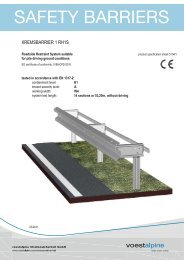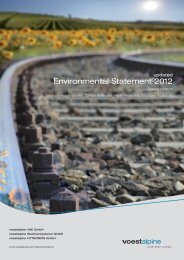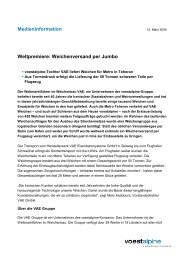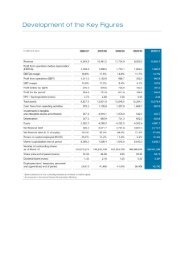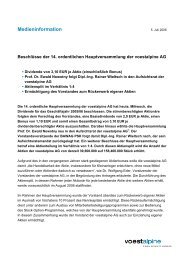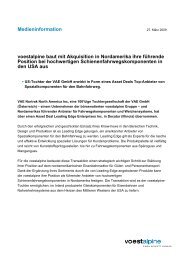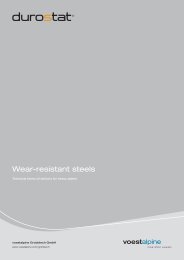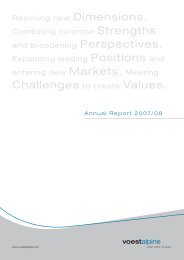Annual Report 2005/06 - voestalpine
Annual Report 2005/06 - voestalpine
Annual Report 2005/06 - voestalpine
Create successful ePaper yourself
Turn your PDF publications into a flip-book with our unique Google optimized e-Paper software.
marKeT environmenT anD<br />
BUsiness perFormanCe<br />
The total crude steel production worldwide<br />
in the past year was 1.13 billion tons. As<br />
compared to 2004, this is an increase of<br />
6.8%, which is slightly lower than the growth<br />
from 2003 to 2004 (just over 9%).<br />
The steel production in China, the country<br />
largely responsible for the increase, went<br />
up from 280.5 to almost 350 million tons in<br />
<strong>2005</strong>, a jump from about one quarter of the<br />
global market share to just above 30%. With<br />
a share of 17%, the European Union remained<br />
the second largest steel producer,<br />
although the crude steel production in the<br />
EU (25) during the past year was down for<br />
the first time in quite a while. The development<br />
in the individual countries was very<br />
differentiated, but overall, production declined<br />
from 193.4 million tons to 186.2 million<br />
tons mainly because of consolidations<br />
and restructuring.<br />
The continuing dynamic situation in the<br />
Chinese steel industry was again the major<br />
influence on the commodity markets which<br />
showed a significantly rising overall price<br />
trend. Additionally, the massive surge in<br />
energy prices, driven particularly by oil and<br />
natural gas, had a considerable adverse impact<br />
on the steel industry.<br />
After the steel boom of 2004, which led to a<br />
substantial increase of imports, the beginning<br />
of the <strong>2005</strong>/<strong>06</strong> business year was somewhat<br />
restrained in the flat steel products<br />
sector. High inventory on the part of customers<br />
led to lower demand and new orders that<br />
trickled in sluggishly. As a result, the steel<br />
prices came under pressure, resulting in<br />
significant price declines, especially in the<br />
commodity sector. Europe-wide, steel producers<br />
reacted by lowering production, leading<br />
to a decrease in customer inventory and<br />
a stabilization of the market beginning with<br />
the third quarter of the business year. During<br />
the first half of <strong>2005</strong>/<strong>06</strong>, the difficult<br />
economic environment resulted in slightly<br />
lower prices in the Division Steel as well,<br />
although the decline was considerably less<br />
dramatic than the industry average. After a<br />
stabilization in the third quarter, the fourth<br />
quarter of the business year saw incoming<br />
orders go up substantially.<br />
Because of the boom in the energy sector,<br />
demand in the heavy plate grades sector<br />
(especially for off-shore steel grades and<br />
special grades for sophisticated pipeline applications)<br />
remained stable at a high level.<br />
Overall, the Steel Service Center Group<br />
(custom-made pre-processing) was utilized<br />
to capacity, while the Steel Trading Group<br />
was confronted with weaker demand as a<br />
result of market conditions. Also driven by<br />
Divisional <strong>Report</strong>s<br />
<strong>Annual</strong> <strong>Report</strong> <strong>2005</strong>/<strong>06</strong><br />
1



